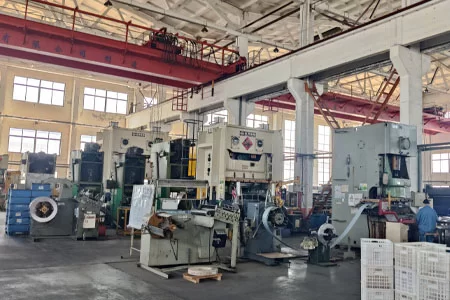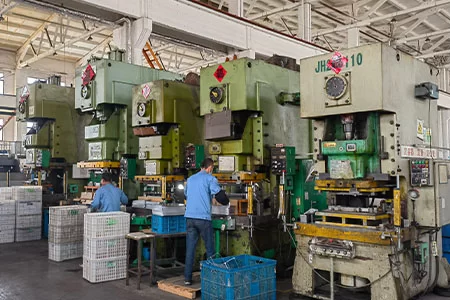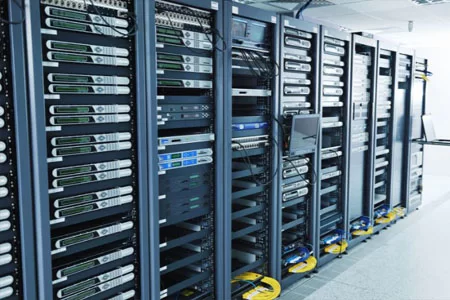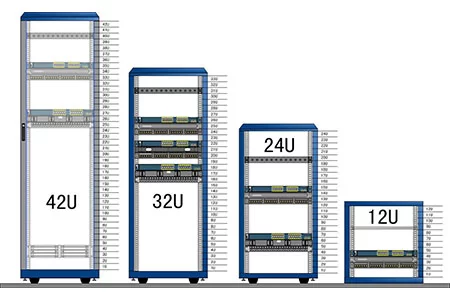This blog post provides a comprehensive look at Network Server Blank Panels, essential components that ensure the safety, efficiency, and visual appeal of modern data centers. We cover every detail—from a full overview and critical design parameters (incl

Enhancing Data Center Efficiency with Precision-Engineered Blank Panels
Unlocking the Power of Network Server Blank Panels for Superior Server Enclosures
-
Home>
-
Blog>
-
Technology>
Optimized Network Server Blank Panel Solutions for Modern Data Centers
Comprehensive Overview of Network Server Blank Panels
Network Server Blank Panels are indispensable components in modern data centers and server racks, designed to cover unused slots and provide a uniform, secure enclosure. These panels prevent the ingress of dust and foreign objects, help maintain optimal airflow for cooling, and safeguard against accidental contact with live equipment. At HULK Metal, we manufacture blank panels that blend functionality with aesthetics—ensuring a sleek, professional appearance in your server room while meeting strict industry standards. Our panels are engineered to be robust yet easy to install, offering a seamless fit with standard rack dimensions. With the flexibility to customize designs to match specific rack configurations, our products guarantee enhanced safety and improved thermal performance. Whether you're upgrading an existing installation or building a new data center, our advanced production techniques deliver precise, high-quality blank panels that elevate both performance and visual appeal.
Important Parameters of Network Server Blank Panels
When it comes to Network Server Blank Panels, understanding the key design parameters is essential for ensuring compatibility, performance, and longevity in your data center environment. One of the most critical parameters is the panel thickness. Typically, our panels are engineered with thicknesses ranging from 1.5 mm to 2.5 mm. This range provides an ideal balance between durability and weight, ensuring that the panels are robust enough to protect internal components while remaining manageable for installation.
Dimensions
also play a vital role in the performance of a blank panel. Standard panels are designed to fit common server rack sizes, with typical widths of 450 mm to 600 mm and heights that can range from 600 mm to 1200 mm depending on the rack configuration. These dimensions ensure a snug fit, reducing any risk of gaps that could compromise airflow or security. For instance, a popular model may feature a 1.8 mm thick panel measuring 600 mm in width and 800 mm in height—dimensions that have been proven to offer excellent structural integrity and compatibility with a wide range of server racks.
Edge Finishing and Tolerances
are other crucial factors. Precise cutting and finishing techniques are employed to achieve tolerances within ±0.2 mm. This precision minimizes any misalignment during installation and ensures that the panels maintain their structural and aesthetic integrity over time. Additionally, the quality of the edge finishing contributes to the overall safety by eliminating sharp edges that might pose risks during handling.
Ventilation Features
are often integrated into the design of our blank panels. Some models incorporate strategically placed perforations or slots that measure between 5 mm to 10 mm in diameter. These openings are engineered to optimize airflow, ensuring that heat is effectively dissipated while maintaining the panel's strength. In high-density environments where thermal management is critical, such ventilation options can help reduce the risk of overheating and improve overall energy efficiency.
Another Parameter To Consider
is the weight of the panel. Our designs aim to keep the weight in check—typically around 2 to 4 kg per panel—so that installation and maintenance are streamlined. A lightweight design not only reduces the physical strain during installation but also minimizes the load on the rack structure, contributing to overall system longevity.
Surface Finish and Coatings
also impact performance. Panels may feature a matte or glossy finish, with coatings that enhance corrosion resistance and reduce fingerprints. These finishes not only improve the visual appeal but also extend the panel's service life in harsh environments. For example, an anti-corrosive coating can increase the longevity of a panel by up to 30% compared to untreated surfaces.
Customization Options
allow clients to tailor the panels to specific requirements. Beyond standard dimensions and thickness, additional features such as integrated cable management clips, custom colors, or branding elements can be incorporated. This flexibility ensures that the blank panels are not only functional but also aesthetically aligned with the overall design of the data center.
By combining these critical parameters—thickness, dimensions, precision tolerances, ventilation features, weight, and surface finish—HULK Metal ensures that every Network Server Blank Panel meets the rigorous demands of modern server environments. Our advanced production techniques and strict quality control processes guarantee that every panel is engineered to deliver optimal performance, enhanced safety, and a refined appearance that complements your data center infrastructure.
Common Types, Their Pros, Cons, and Applications
Network Server Blank Panels come in a variety of designs, each tailored to meet the specific needs of different data center environments. Understanding the common types available—and the advantages and disadvantages of each—helps you make an informed decision that best suits your installation requirements.
Fixed Blank Panels:
Fixed blank panels are designed to provide a permanent cover for unused slots.
Pros:
They offer superior security by preventing accidental access to internal components.
Their rigid construction ensures excellent durability and a seamless, uniform appearance.
Installation is straightforward, making them ideal for static, long-term setups.
Cons:
Their inflexibility can be a drawback if future reconfiguration of the server rack is needed.
Once installed, modifications require removal and replacement, which can be time-consuming.
Applications:
Fixed panels are best suited for mature data centers where server configurations are unlikely to change over time and where a permanent, secure solution is paramount.
Removable or Adjustable Blank Panels:
These panels offer flexibility for dynamic environments, where frequent reconfigurations are common.
Pros:
They provide ease of access for maintenance, allowing technicians to quickly remove and replace panels as needed.
The adjustable design accommodates future changes, offering versatility in evolving installations.
Many come with tool-less mechanisms that streamline the process, reducing downtime during maintenance.
Cons:
The adjustable mechanisms might compromise overall rigidity, potentially reducing physical protection compared to fixed panels.
They can be slightly more expensive due to the added design complexity and additional moving parts.
Applications:
Removable panels are ideal for test environments, data centers with evolving configurations, or any installation where frequent access and adjustments are required.
Ventilated Blank Panels:
Ventilated panels integrate design features that promote enhanced airflow.
Pros:
Strategically placed perforations or mesh patterns help to dissipate heat effectively, improving thermal management.
They contribute to energy efficiency by maintaining optimal cooling and reducing the likelihood of overheating.
The open design can aid in reducing hotspots within densely populated server racks.
Cons:
The open structure may reduce physical protection against dust and foreign objects.
In environments with high levels of particulate matter, additional measures such as filters may be necessary to prevent debris ingress.
Applications:
Ventilated panels are especially beneficial in high-density installations or data centers where thermal management is a top priority, ensuring that critical components remain cool under heavy load.
Custom-Fit Blank Panels:
For installations that require non-standard dimensions or additional functionality, custom-fit panels offer a bespoke solution.
Pros:
They are precisely engineered to match unique rack dimensions and specific design requirements.
Custom features such as integrated cable management clips, branding, or color matching are readily available.
Their tailored nature ensures a perfect fit and seamless integration with existing infrastructure.
Cons:
The customization process can lead to longer production times and higher costs compared to standard models.
Precise input is required from the client, and any design changes can complicate the production process.
Applications:
Custom-fit panels are ideal for specialized data centers, unique installations, or scenarios where off-the-shelf solutions fail to meet operational or aesthetic requirements.
Hybrid Blank Panels:
Hybrid panels combine features from fixed, removable, and ventilated designs to deliver a versatile solution.
Pros:
They offer a balanced mix of durability, flexibility, and thermal performance.
Modular components allow for easy configuration changes without compromising the panel's structural integrity.
Hybrid designs can be adapted to a wide range of applications, making them a cost-effective solution for diverse environments.
Cons:
The complexity of hybrid designs may result in a higher price point and a steeper learning curve during installation.
They might require specialized installation techniques to ensure that all integrated features function correctly over time.
Applications:
Hybrid panels are best suited for cutting-edge data centers that require both high performance and flexibility, enabling organizations to balance security, access, and cooling needs in a single solution.
Each type of Network Server Blank Panel offers unique benefits and trade-offs. Fixed panels ensure maximum security and durability for static configurations, while removable panels provide the flexibility needed in dynamic environments. Ventilated panels excel in thermal management, and custom-fit or hybrid solutions deliver tailored performance to meet specialized requirements. By carefully evaluating the operational needs of your data center—considering factors such as access frequency, cooling efficiency, and potential future modifications—you can select the panel type that provides the best overall balance of performance, aesthetics, and cost.
Materials Used in Network Server Blank Panels: Advantages and Disadvantages
The choice of material for Network Server Blank Panels is pivotal, as it directly affects durability, aesthetics, thermal performance, and overall cost. At HULK Metal, we offer a range of material options, each with distinct advantages and limitations, to suit various application scenarios in modern data centers.
Steel:
Steel is renowned for its strength and durability.
Advantages:
Superior Strength and Security: Steel panels, typically with thicknesses ranging from 1.5 mm to 2.5 mm, provide excellent protection against physical impacts and unauthorized access.
Heat Dissipation:
The inherent thermal conductivity of steel helps in dissipating heat, contributing to a stable internal environment in server racks.
Long-Term Durability:
With proper coatings to prevent corrosion, steel panels can maintain their integrity in demanding environments for many years.
Disadvantages:
Weight Considerations:
Steel panels are heavier—often weighing between 3 to 5 kg per panel—which can complicate installation and require reinforced mounting systems.
Corrosion Risk:
Without adequate treatment, steel is susceptible to rust, particularly in high-humidity or corrosive environments.
Aesthetic Limitations:
While functional, the industrial look of untreated steel may not always align with modern data center aesthetics.
Aluminum:
Aluminum offers a strong yet lightweight alternative to steel.
Advantages:
Lightweight and Easy to Handle:
Aluminum panels typically weigh 2 to 3 kg, facilitating quicker installation and less strain on rack structures.
Natural Corrosion Resistance:
Aluminum's natural resistance to corrosion reduces the need for extensive protective coatings, ensuring a longer service life.
Efficient Thermal Performance:
Although not as conductive as steel, aluminum still offers excellent heat dissipation properties while maintaining a modern, sleek appearance.
Disadvantages:
Cost Implications:
The raw material cost of aluminum can be higher than that of steel, impacting overall production expenses.
Structural Rigidity:
In some cases, aluminum panels may not provide the same level of impact resistance as steel, potentially limiting their use in high-security environments.
Finish Variability:
The final appearance can vary based on the manufacturing process and may require additional finishing steps for a premium look.
High-Grade Plastics (PVC, Polycarbonate):
High-grade plastics are increasingly popular for applications where weight and design flexibility are key.
Advantages:
Cost-Effective Production:
Plastics are generally less expensive than metals, making them a viable option for budget-conscious projects.
Malleability:
These materials can be easily molded into complex shapes, allowing for creative design features such as integrated ventilation patterns or cable management channels.
Lightweight Construction:
Plastic panels are exceptionally light, often weighing less than 2 kg, which simplifies handling and installation.
Disadvantages:
Lower Heat Resistance:
Plastics typically have lower tolerance to high temperatures compared to metals, which can be a drawback in heat-intensive environments.
Reduced Impact Resistance:
While durable for many applications, high-grade plastics may not offer the same protection against physical impacts as metal alternatives.
Potential for Degradation:
Over time, exposure to UV light or harsh chemicals may lead to discoloration or brittleness if not properly treated.
Composite Materials and Hybrids:
Composite materials, such as fiber-reinforced polymers (FRP), and hybrid solutions that combine different materials, are designed to leverage the benefits of each component.
Advantages:
Balanced Performance:
Composites can be engineered to provide high strength, low weight, and excellent thermal management, often achieving performance metrics similar to metals while remaining cost-effective.
Customization Flexibility:
These materials allow for the integration of additional features, such as anti-corrosive layers or enhanced ventilation channels, tailored to specific customer requirements.
Enhanced Durability:
Composites are resistant to corrosion and chemical exposure, making them ideal for harsh or variable environments.
Disadvantages:
Higher Production Complexity:
Manufacturing composites often requires specialized equipment and processes, potentially leading to longer lead times and higher production costs.
Cost Considerations:
The advanced technology used in composite production can drive up costs, particularly for highly customized solutions.
Maintenance and Repair:
In some cases, repairs to composite panels may be more challenging than with traditional metal or plastic panels, necessitating specialized service protocols.
Ultimately, the selection of material depends on the specific requirements of your data center. Steel offers unparalleled strength and longevity, while aluminum provides a lightweight, corrosion-resistant alternative with a modern aesthetic. High-grade plastics deliver cost efficiency and design versatility, and composites or hybrid materials offer a tailored balance of performance features. At HULK Metal, we work closely with our clients to choose the optimal material solution, ensuring that every Network Server Blank Panel meets the highest standards of durability, thermal performance, and aesthetic appeal.
Key Considerations When Choosing a Contract Manufacturer for Network Server Blank Panels
Selecting the right contract manufacturing partner for your Network Server Blank Panels is crucial to achieving high-quality, reliable products that enhance your data center's efficiency and safety. Below are the key factors to consider when evaluating potential partners:
Industry Experience and Expertise:
Look for a manufacturer with extensive experience in producing server enclosure components. A proven track record in fabricating precision-engineered blank panels is a strong indicator of quality. HULK Metal has years of experience in metal and sheet processing, ensuring every panel is produced with rigorous attention to detail and adheres to industry best practices.
Advanced Production Capabilities:
The production facility should be equipped with state-of-the-art machinery capable of achieving tight tolerances and consistent quality. This includes precision cutting equipment, advanced CNC machinery, and automated quality control systems. While we do not disclose specific brands, our facilities are designed to handle everything from small-batch prototyping to high-volume production without compromising quality. High precision in dimensions—such as maintaining panel thickness within ±0.2 mm and accurate width and height measurements—is critical for a perfect fit in standard server racks.
Quality Control and Compliance:
Ensure that the manufacturer adheres to international quality standards and maintains rigorous quality control protocols throughout the production process. Certification in relevant quality systems, regular inspections, and documented quality assurance processes provide confidence that each panel will perform reliably. At HULK Metal, our commitment to quality is backed by comprehensive testing at every production stage, ensuring that every blank panel meets or exceeds industry benchmarks.
Customization and Flexibility:
Your data center's requirements may evolve over time. A manufacturing partner that offers high levels of customization—from tailored dimensions and material choices to additional features such as integrated cable management clips or custom finishes—can provide a significant advantage. Flexible production processes enable quick adaptations to new designs or changes in specifications without lengthy delays.
Integrated Supply Chain and Logistics:
A robust, end-to-end supply chain is essential for maintaining consistent production quality and on-time delivery. Evaluate whether the manufacturer manages every stage—from raw material sourcing and fabrication to final inspection, packaging, and logistics. At HULK Metal, our fully integrated supply chain minimizes delays and ensures that every blank panel is delivered on schedule, reducing downtime and streamlining installation.
Transparent Pricing and Cost Efficiency:
Budget considerations remain a critical factor. While quality should never be compromised, transparent pricing models with detailed cost breakdowns help ensure that there are no hidden fees. Compare quotations from multiple manufacturers and evaluate how each factor—quality, production speed, customization options, and aftersales support—contributes to the overall value proposition.
Communication and Customer Service:
Effective communication is key throughout the design, production, and delivery phases. A dedicated project management team that offers regular updates and is responsive to inquiries can significantly smooth the manufacturing process. HULK Metal prides itself on providing personalized customer service, ensuring that your specific needs and any changes in your project are addressed promptly.
After-Sales Support and Warranty:
A manufacturer that stands behind its product should offer comprehensive aftersales support. Inquire about warranty policies, repair services, and protocols for handling any defects or discrepancies post-delivery. Reliable aftersales support can save time and reduce overall costs in the long run, offering peace of mind that any issues will be promptly resolved.
Innovation and Future-Proofing:
Choose a partner that invests in research and development to stay ahead of industry trends. A commitment to continuous improvement means that the manufacturing process and product designs are regularly updated to incorporate the latest advancements in technology and production techniques. This proactive approach ensures that your Network Server Blank Panels remain relevant and high-performing as data center technologies evolve.
By carefully evaluating these factors—industry expertise, advanced production capabilities, rigorous quality control, customization flexibility, supply chain integration, transparent pricing, effective communication, reliable aftersales support, and a commitment to innovation—you can confidently select a contract manufacturing partner that aligns with your strategic goals. At HULK Metal, our comprehensive approach to production and customer service ensures that every blank panel we produce meets the highest standards, offering exceptional performance and value for your data center.
Article Navigation
Article Navigation
Industries
Foundries
-

November.21, 2024
HULK Metal Stamping Factory Show
READ MORE
-

October.18, 2024
HULK Metal Fabrication
READ MORE
-

February.21, 2025
Choose a Suitable OEM Factory to Produce Your Network Server Racks
READ MORE
-

February.21, 2025
1U, 2U 18U, 42U, What That Mean
READ MORE
-

February.21, 2025
How Should You Choose A Suitable OEM Factory to Produce Your Network Server Accessories
READ MORE







